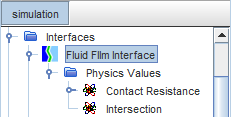Fluid Film Interface
The fluid film interface type is used to join a fluid and a fluid-film region.
It represents the contact surface between two fluids. It has properties, conditions, values, and a pop-up menu.


Modeling
- The equation for mass conservation is used to calculate the film thickness. The volume and surface area of the film are functions of the thickness. Contributions to mass source or sink come from droplet impingement, film stripping, mass transfer, or user-defined sources.
- The equation for momentum conservation is based on kinematic and dynamic conditions at the interface between the film and the surrounding fluid (film free surface).
- The equation for energy conservation is based on contributions to the energy source or sink from droplet impingement, film stripping, or user-defined sources.
Fluid Film Interface Properties
You can use the properties that are listed below to adjust the specifications of a node.
- Boundary-0
- Indicates the "fixed" side of the interface (Read Only).
- Boundary-1
- Indicates the "adapted" side
of the interface (Read Only).
Vertices from boundary-1 are projected onto boundary-0. The orientation can be swapped through the right-click action Reverse Orientation.
- Type
- Defines the type of interface. Must be set to Fluid-Film Interface.
- Topology
- Defines the connection type
between the interfaces:
- In-place—uses the in-place topology.
- Periodic—uses the periodic topology.
- Repeating—uses the repeating topology.
- Connectivity
- Defines how the boundaries on the two sides of the interface are connected. Fluid Film interfaces have Imprinted connectivity type. The imprint connectivity type indicates the interface is within regions that are discretized using the finite volume method. The imprint procedure creates intersected faces.
Fluid Film Interface Values
You can use the properties that are listed below to adjust the specifications of a interface node.
- Contact Resistance
- The value of the resistance to conduction through the interface. It is
entered as a scalar profile. If a field function defines the value and the
Ignore Boundary Values property on the field function is ticked, the
function is computed using data from the cell next to the boundary. The
available properties are:
- Dimensions: specifies the resistance in units of or similar. (Read Only)
- Method: specifies the input method type from , , , or .
- Intersection
- Available for all direct interfaces to control the intersection tolerance.
The available properties for fluid film interfaces are:
- Specify by Part Subgroup
- Specifies sub-grouping for contact-mode boundary interfaces to set up independent intersection properties. See also Contact-Mode Boundary Interfaces and 调整交界面相交容差(基于几何的方法).
- Geometry-Based (Legacy)
- This
Direct
Intersector option activates:
- Geometric Tolerance: Specifies the maximum projection distance of adapted vertices onto the fixed side in terms of a fraction of minimum local edge length around each vertex. For more details, refer to 调整交界面相交容差(基于几何的方法).
- Topology-Based with Connectivity Imprinted
-
- Match Outer
Boundary: when activated,
indicates that the interface boundaries are expected to
fully overlap on large-scale topological features.
Activate this option only when you expect a complete
match of the two boundaries of an interface.
By default, this property is deactivated.
- Projection
Tolerance: maximum orthogonal
projection distance in terms of a fraction of local
element diameter. Places a limit on how the vertices of
the adapted side get projected onto the fixed side. In
cases where the two interface boundaries are separated
by greater distances, you can increase the Projection Tolerance value to
get fewer remainder faces.
By default, the tolerance is set to 0.2.
- Angle
Threshold: maximum angle (deg)
by which the intersector identifies large-scale features
that are mapped from the adapted side onto the fixed
side. To preserve sharper features, specify a smaller
Angle Threshold value. If
the boundary meshes have spurious defects, you can
specify a larger value.
By default, the value is set to 45 deg.
- Match Outer
Boundary: when activated,
indicates that the interface boundaries are expected to
fully overlap on large-scale topological features.
Activate this option only when you expect a complete
match of the two boundaries of an interface.